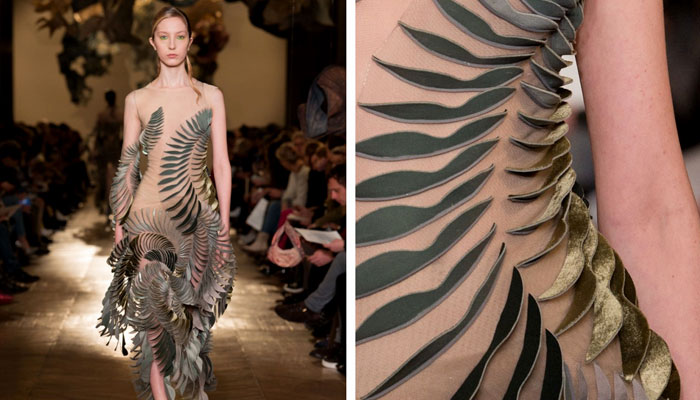
Plastics are chic!
Needless to say, plastics thread their own way
She wore boots of glittering black vinyl. Boots made for walking or trampling unfaithful men. For many, Nancy Sinatra and her famous song will remain undisputed icons of the 1960s in the same way as the plastics which were gradually garnering interest among the great designers such as Courrège, Saint Laurent, Rabanne and even the more traditional Cardin. It was a decade of daring, in which stylists would throw off the yoke of still very "bourgeois" style codes.
|
At a time when women were timidly seeking to emancipate themselves, fashion designers helped them by enabling them to highlight their bodies and proudly display their femininity. Englishwoman Mary Quant made headlines by launching the miniskirt, a liberating element that, in her own words, would enable women to run after a bus while maintaining freedom of movement.
|

Considered cutting-edge at the time, fashion designers began using plastics heavily in the 1960s |
Clothes became temporal markers and “trendy” people had to ceaselessly extend their wardrobes to remain "in". Textile workshops operated at full capacity and synthetic materials such as polyamides, acrylics and polyesters began to emerge. Several factors led to this: they were inexpensive to produce, they allowed for a lot of extravagance and their elasticity made it possible to design clothes that were very form-fitting as required by the trends of the time. Finally, they were also supposed to free women. And for good reason, some commercials did not hesitate to announce that these textiles were wrinkle-free and that they therefore did not require ironing. This era also saw the apotheosis of nylon tights that made stockings and garter belts a thing of the past in just a few years.
It was also the time of the conquest of space, a symbol of modernity if ever there was one. The astronauts in their white outfits were a source of awe and inspiration. Fashion designers turned to PVC, which was re-christened Skai to add to its aura of chic-ness, and used it endlessly in myriad leather goods and shoes. Paco Rabanne pushed the concept even further by designing mules and even a raincoat molded from a single piece of PVC. The end of the 1960s was also marked by the first animal protection movements. Fur was stigmatised. Riding on this nascent movement, Yves Saint-Laurent filled runways with models wearing beautiful coats of multicoloured furs made entirely of acrylics.
Paco Rabanne was the first to design a dress consisting of an assembly of plates of rhodoid, a polymer based on cellulose acetate, held together by small metal hooks. This conceptual garment proved that new modern materials such as plastics made needle and thread a thing of the past. The dress inspired others who would go on to change the shape of the hooks to make them easily detachable. Garments became modular, and it was a matter of a few seconds to change from a miniskirt to a long skirt. Clothes were now able to adapt to the wearer’s moods and desires.
Polymers: fashion designers take control
Spoilsports will say that everything has already been done and that fashion is doomed to endlessly repeat itself. We shall leave that discussion to the experts. What is certain, however, is that plastics are still popular in the fashion industry and more generally in the haute couture and luxury ready-to-wear industries. Overall, it is always the same polymers that are most used and vinyl, the other name for PVC, is cyclically the star of the runways.
Its perfect transparency is largely responsible for its prominent role because fashion designers like to play with light effects, especially when they can be reflected on the skin. This is also a way of designing clothes that protect without hiding too much. For more than 60 years now, fashion designers, regardless of their gender, have pursued the same objective: highlighting the female body first and foremost.
Vinyl was one of the big surprises of the 2018 fashion week. One could almost believe that fashion designers had conspired together so prevalent was the material in their shows. Obviously, it was at its most recognisable when it took the shape of odd and unique raincoats. The specialised press jumped on the bandwagon and vaunted the merits of PVC, as if there were chic plastics and others. Regardless, vinyl was indeed the standout of the 2018 season, especially as many designers used it with a certain degree of humour, such as using it to imitate the lines of a very traditional suit.

Fur made a major comeback in 2018. However, as animal protection is a major issue, the fur is now made from polyester or acrylic. It looks truly realistic and can be made in a range of dazzling colours! |
Taking inspiration from, copying, and more, polymers have long mastered the ability to imitate other materials. In 2018, the organisers of the London Fashion Week proudly announced that that edition would be the first not to feature animal fur. A grassroots movement that now touches every house of haute couture. However, fur is far from passé, especially when used in the collars of coats or parkas. Although synthetic fur has existed for some time, the latest developments in polymers have made it even more beautiful, brighter and even more soft and silky. Polyester and acrylic are the stars in this area, and you need a very good eye to be able to tell real fur and fake fur apart.
Accessories: polymers take the lead
Accessories also make use of plastics to stand out. Chanel unashamedly dared to design the transparent PVC bob and it was far from the only fashion house to fall under the charm of this "so chic " material. Spotted a long time ago by "fashion addicts", Hugo Matha, a young leather goods designer, likes to use different materials for his creations and of course he happily makes use of plastics which he does not hesitate to combine with traditionally more luxurious materials.

Hugo Matha, a young leather goods designer, successfully combined plastics such as PMMA with luxury materials. |
One of the purses in the Carine range, for instance, was created using alligator skin and PMMA. A daring experiment, but the result is as surprising as it is elegant. This type of experimentation can also be found in the work of luxury shoemakers Gianvito Rossi and Louboutin which often use PVC where transparency is required. |
Acne Studio, for its part, attempted to revisit the cult jelly beach sandals by adding leather to their designs while retaining the element that made them so iconic: their PVC structure.
|
Then, and it is almost one of the rules of this universe, more consumer-oriented brands took inspiration from the creations of renowned designers. Their products show varying degrees of talent in recreating other’s designs.
And it worked! Teenagers in Japan immediately jumped on the trend and started proudly sporting transparent caps bearing the logo of a brand of food bags. |

Japanese brand Beams Couture successfully turned an ordinary polyethylene freezer bag into an ultra-trendy fashion accessory. |
3D printers go from strength to strength
We remember the buzz triggered a few years ago by Dutch designer Iris Van Herpen who used many synthetic textiles to create clothes with incredible visual effects.
She continues working towards this objective by always being on the lookout for new materials and innovative manufacturing techniques. Her latest stroke of brilliance did not go unnoticed. And for good reason, as she is the first fashion designer to have used a 3D printer to bring her creations to life.
To do this, she partnered with the Delft University of Technology in the Netherlands to develop a hybrid printing technique that combines a 3D-printed polymer with natural fabric. The plastic patterns are printed directly onto a piece of tulle. For the Delft team, it is a real feat using technology that is still kept secret. It is therefore difficult to guess which polymer and which technique were used. All that we know is that the dress consists of 30cm by 30cm panels which were then assembled using traditional sewing techniques. A single dress requires 260 hours of printing and 60 hours of manual work for assembly. It seems that Iris Van Herpen is not the only designer to have taken an interest in these new technologies.

Always at the forefront of innovation, designer Iris van Herpen uses a 3D-printed polymer to make some of her fabrics. |
In Spain, the Eurecat Technology Centre has succeeded in developing a 3D printer capable of continuously printing patterns using PLA, a biobased polymer, on all types of fabrics. The innovation in terms of machinery, compared to that developed in the Netherlands, is based on technology that now makes it possible to print the entire length of the roll of cloth instead of printing smaller individual sheets. Patents are still in the process of being filed, but this technique would certainly turn the whole textile industry upside down were it to become more widespread.





